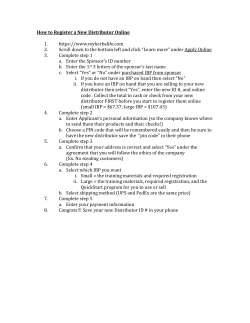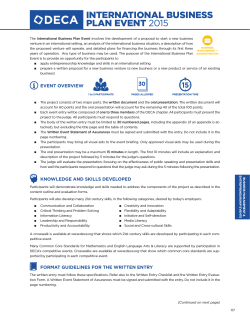
An Executive Guide to Integrated Business Planning 20 questions you should ask...
Inspiring Business Performance An Executive Guide to Integrated Business Planning 20 questions you should ask... and the answers you should expect Integrated Business Planning 20 questions you should ask 01 02 03 04 05 06 07 08 09 10 What is Integrated Business Planning (IBP)? What are the principle goals of IBP? What are the biggest challenges in implementing IBP? Who in the organisation owns the IBP process? How is the success of IBP measured? Is IBP only suitable for organisations of a certain size or level of planning sophistication? What are the key factors to consider in establishing a successful IBP process? How does the monthly IBP review process work? How do you decide which information is critical to the IBP process? How do you make sure data for IBP is clean, accurate and current? 11 12 13 14 15 16 17 18 19 20 At what level of granularity should you be planning for IBP? How does IBP exert control over the supply chain? Does IBP require a dedicated IT solution? Has globalisation and increased supply chain complexity impacted planning frequency? How does IBP allow for flexibility in supply chain planning? Can IBP optimise inventory? How long does it take? How much does it cost? What personnel do you need to commit to IBP? How do you get started? What is Integrated Business Planning (IBP)? 01 Integrated Business Planning (IBP) can most simply be described as advanced, or next-generation, sales and operations planning (S&OP). IBP represents the evolution of S&OP from its production planning roots in the 1970s into a fully integrated management and supply chain collaboration. Over the years conventional S&OP has typically been assigned as a supply chain process, balancing supply and demand over a one to 12 month horizon, with no real financial integration; the focus on the short term and on the numbers, rather than the issues. IBP is the business planning process for the post-recession era; integration is what distinguishes it from its predecessor and it brings with it a truly strategic perspective. Led by the executive team, IBP is a common sense process designed for effective decisionmaking. It allows senior management to plan and manage the entire organisation over a 24 month horizon or more, aligning strategic and tactical plans each month, and allocating critical resources – people, equipment, inventory, materials, time and money – to satisfy customers in the most profitable way. What are the principle goals of IBP? 02 A successful IBP process allows an organisation to plan for success and then align the entire organisation to execute against this common plan. Key to the IBP process is a rolling 24 month integrated volumetric and financial plan (‘one set of numbers’) that covers the product portfolio, demand and supply. It establishes a bottom-up realistic plan and ensures early focus on any potential gaps in business performance against targets, business plans, goals and strategic plans, allowing organisations to predict and respond positively to changing conditions, in plenty of time. So whatever lies ahead, IBP can help you plan for it. What are the biggest challenges in implementing IBP? 03 Understanding, leadership and commitment. The biggest challenge in implementing an IBP process, or transitioning from S&OP to IBP, is for organisations to comprehend the true scale of what the process can achieve for the business, and for the leadership team to be prepared to commit to a new style of running the business. Then comes the sizeable challenge of overcoming the traditional thinking of operating in functional silos, and to integrate all the key areas of the business (Product, Sales, Marketing, Supply, Finance, R&D, etc) into a single integrated business planning process. Who in the organisation owns the IBP process? 04 The owners of the IBP process should be the business leader and the leadership team – without buy-in at the top, it cannot succeed. Achieving ownership at the senior level is really about engagement in understanding of the process at that level and of the significant benefits that can come from integrated planning. How is the success of IBP 05 Ultimately a successful IBP process will bring a substantial return to the bottom line, but success is also measured through the execution of the business plan in a cohesive and efficient manner, right across the organisation, so the predicted results for the business can be achieved. IBP allows the leadership team to get a realistic view of where the business is planning to be, and make real decisions ‘now’ to influence that position. This enables top line growth as well as cost efficiency, through early action in preventing loss of business and exploiting new opportunities. Many executives speak of control of the business; understanding the business; visibility of expected business outcomes; and business growth. Some of the benefits IBP delivers to Oliver Wight clients Revenue growth Reduction in ‘cost of non-quality’ SKU rationalisation Improved customer service Increased efficiency Inventory reduction Is IBP only suitable for organisations of a certain size or level of planning sophistication? 06 It is not really a question of size or sophistication but more of correct process design – to fit the style and shape of organisation. Clearly single site businesses will have different requirements to those of global matrix-structured organisations. Oliver Wight’s experience is that all successful organisations, whatever their size or sector, are those continually trying to improve their business planning process. Ultimately a successful IBP process will bring a substantial return to the bottom line, but success is also measured through the execution of the business plan in a cohesive and efficient manner. S&OP and IBP: Decades of Evolution What are the key factors to consider in establishing a successful IBP process? 07 • Strong leadership is all-important • People are fundamental • Education drives behavioural change • Creating internal experts within the organisation • Developing multi-disciplined teams • Consistent processes with clear responsibilities and accountabilities • 24 month rolling horizon with a focus on the longer term; not the short term • Aggregate planning – what will be the core family and segment groupings used to promote the right discussions within the reviews • Monthly frequency of review – rather than quarterly or weekly • High quality and timely availability of information – flowing bottom-up • Honesty and trust in the numbers How does the monthly IBP process work? 08 There are five steps in the monthly IBP review process. These are not a series of discovery meetings but a continuous process of orchestrating those who are business-accountable to review, present and communicate progress and change. The reviews must be action-oriented and they demand rigorous preparation to identify issues and scenarios for consideration in advance of the meeting, so decisions can be made and revised plans agreed before they are made visible across the entire integrated process. The review meetings are diarised from the outset and those involved have to prioritise those dates – nothing should be more important; after all, this is the management process running the entire business. 1. Product Management Review: A crucial difference between IBP and a typical S&OP process is the inclusion of product management. This review is fundamental to understanding which product changes or key initiatives being planned will have a direct impact on the business and most importantly, whether they are on track to deliver to expectations: What changes are taking place (and when) over the horizon to ensure an attractive product portfolio, that will deliver market share and profitability objectives? Which products will be introduced, discontinued or changed; what will be the effect of marketing-led promotional activity; and what is the time-phased plan? 2. Demand Review: Demand will change in response to economic, industry and market forces – growth, inflation, exchange rates, consumer confidence, competition, promotional activity, the availability of new products and so on. The demand review is to assess and develop forecasting capability and sales planning performance, and to use this information to generate the latest view from marketing and sales, underpinned with volume and revenue projections. Assumptions must be documented to provide visibility and understanding, and the sales and marketing views reconciled to gain consensus on a ‘most likely’ demand plan. The review meetings are diarised from the outset and those involved have to prioritise those dates. 3.Supply Review: A review of how the supply chain is performing – from supplier delivery, through conversion and master supply plan performance. What is the demonstrated performance of operations and what is the timing of improvement programmes, so there is clear understanding of supply capability and flexibility? What is the impact on the supply chain of changes in demand and the timing of product development? Are there material constraints in supporting the new demand plan and is there sufficient resource? What are the options and opportunities? 4. Integrated Reconciliation: Change would typically have been identified in all of the above reviews and a continuous reconciliation process is required to address and resolve the issues arising; to re-optimise the business, and manage any gap between the business strategy and the updated view of forward business performance. Reconciliation needs to get beyond the numbers to a real understanding of the key business levers and forces at work, and to model scenarios. The integrated picture and real management issues can then be presented to the senior team succinctly, with options and recommendations. 5.Management Business Review: This final step must be based on real management information – a review of key performance indicators and analysis of trends in operational and financial performance, highlighting gaps versus business and strategic plans. It will present issues arising, together with the underpinning understanding of assumptions, vulnerabilities and opportunities, which have either been resolved at prior steps, or require a decision based on the recommendations from the reconciliation review. This review will approve the revised forward plan which will provide clear visibility for the single set of numbers driving the business. Recognition by the leadership team that data and how it can be transposed into information, is critical. How do you decide which information is critical to the IBP process? 09 Deciding which information is critical to IBP, should again start at the top. The key is for the executive to understand which information they need in order to make real decisions to help influence the future performance of the business. The leadership team must set its expectations through the design of the monthly IBP management business review – the final phase of the monthly IBP cycle. This review, attended by the company’s most senior executive, is fed by the IBP’s Integrated Reconciliation process – its function and that of its leader is to ensure only the key issues get to the leadership team and that the information is of the highest quality. How do you make sure data for IBP is clean, accurate and current? 10 Data accuracy is obviously critical to any business process; not just IBP. Recognition by the leadership team that data and how it can be transposed into data requires passion and commitment to data excellence – from the leadership team, down through all levels in the organisation. And of course, what information, is critical – to the extent that data should be owned by the leadership team. This may require a substantial change of behaviour. Delivering accurate gets measured, gets done. So having a measurement system to track the accuracy of data is critical. At what level of granularity should you be planning for IBP? 11 Although accurate data is vital, there is also a danger in getting too bogged down with detail. The planning granularity will depend at the level of the organisation it takes place and therefore, on which planning horizon – short term planning, in parallel with IBP, would of course be in detail and by SKU. However for the IBP process itself, planning needs to be aggregated by product and process family, as well as channel and segment, to ensure the focus is on changes in the key business assumptions. How does IBP exert control over the supply chain? 12 Part of the challenge with critical suppliers and customers is developing relationships based on trust. Trust can only be generated when people deliver to expectations and to promise. The IBP process can really help this by delivering reliability in the numbers. The greater the collaboration through the numbers, the better the relationships and hence, plans. In areas where there is little control over the outcome, then planning a range of outcomes as well as an integrated view on various scenarios, prepares the business to deal with events, which are not easily controlled. Does IBP require a dedicated IT solution? 13 No. The challenge with IBP is first and foremost about people and process; IBP requires understanding of process and alignment of people’s behaviours. However (software) tools do play a major part in ensuring data and information is available to the process, and in helping to drive improvement in the more sophisticated processes. There has been development in the technology that helps support the IBP process – companies like Oracle and JDA have developed tools to better support the requirements of a truly integrated business process. Has globalisation and increased supply chain complexity impacted planning frequency? 14 There is, and always has been, a need for different planning horizons (short, medium and long term) to be used at different levels within an organisation. However organisations have typically lacked a process which is capable of planning out across all geographical regions and functions, when they are globally integrated. The extension of S&OP to IBP addresses all these horizons and so is designed for complex matrix-structured organisations. Of course short term planning and replanning is an essential component of operational execution; without excellence in these areas, organisations will fail to deliver the optimum results both in regard to customer service and cost. The frequency of Integrated Business Planning must still be monthly as the process re-synchronises the medium to longer term plans against the business plan and strategy. Companies which mistakenly use the monthly process to synchronise the short term are losing out on two fronts – it is impossible to resynchronise the short term quickly enough and they are missing the opportunity to use the process to regularly synchronise the medium-tolonger term. How does IBP allow for flexibility in supply chain planning? 15 Flexibility may or may not be a requirement of a supply chain, depending on the way the business and its supply chain intend to meet customer service levels, and also on the cost-to-serve. Supply chains should be optimised to deliver customer and cost expectations for service etc, and products should be segmented into supply chain bundles to meet that approach. The attention to detail needs to apply to any business process in pursuit of excellence in performance. Increasingly, the “runners” in a supply chain can be left to automated processes, as long as the organisation has the maturity of process to deal with this – as opposed to just seeing this as automation of current processes. This means people in the organisation can focus on the products where there is higher variability and uncertainty. This is a key feature of the IBP process. Can IBP optimise inventory? 16 Yes. However this requires strong management resolve to improve the process. The areas that impact inventory levels are: required customer service levels; forecast variability; variability of supply and the level of investment. Clearly if the level of investment is below that which can be achieved with current performance and variability, then either customer service will be impacted or the business will have to make improvements to meet service levels with the right level of inventory. A good IBP process will drive improvement in many of these process areas, although it is critical for leadership buy-in that the focus of the process is seen as business growth rather than purely as inventory reduction. There is, and always has been, a need for different planning horizons (short, medium and long term) to be used at different levels within an organisation. It’s always best to involve your very best people, since by definition, they will be the most effective and influential in establishing the process with the rest of the workforce. How long does it take? 17 The important thing is to make a start; the benefits and a return on investment can come quite quickly – as long as you stay committed to the process. Some businesses reach Class A status within 12 to 18 months but of course, every organisation’s circumstances are different, and you will work at a pace that suits your particular situation. Naturally, your starting point has a bearing on how quickly you get to where you want to be, as does the complexity and culture of your organisation. But commitment is key – the more determined you are, the quicker you will reach your goals. How much does it cost? 18 Less than you might think. IBP isn’t something that a consulting firm can do for you; it’s something you do for yourselves – with the support of your consultant. At Oliver Wight, we believe in the old Chinese proverb that if you give a man a fish you feed him for a day; but if you teach a man to fish you feed him for a lifetime. Our role is one of education, mentoring and coaching. Successful IBP is only sustainable if you (rather than we) take ownership of it and that way, you will continue to gain improvements long after we’ve left. So you only call on us when you need our help, which means you always keep control of what you spend. That is not to say you shouldn’t be prepared to make a serious financial commitment to implementing IBP, in the same way you’ll need to commit time and resources. We’ll make it clear what you should expect before you start. But you should expect to get at least a tenfold return on your investment. What personnel do you need to commit to IBP? 19 Ultimately, everybody in the organisation needs to be committed. But that commitment begins at the top. You’ll certainly need an IBP champion at the most senior level and then leaders for each of the key processes – product, demand and supply. It’s always best to involve your very best people, since by definition, they will be the most effective and influential in establishing the process with the rest of the workforce. To be successful, the process must come ahead of everything else, so you need to be prepared for your chosen people to be able to dedicate the necessary time and commitment to it; some organisations find it most effective to allocate people full time to the key roles. Communication is key and we’ll help you design and deliver a cascade education process to make sure your entire organisation knows what the goals of your IBP process are; what the benefit is to them; and what the role they are expected to play in its success. How do you get started? 20 Tell us what you’re trying to achieve and if you think we can help you, we’ll arrange to visit your organisation to carry out a diagnostic assessment, benchmark your organisation and prepare an executive briefing: t +44 (0)1452 397200 eemail@oliverwight-eame.com Inspiring Business Performance Oliver Wight has a 40 year track record of delivering business improvement to some of the world’s best-known organisations. We believe that sustainable improvement can only be made through your own people. So unlike other consultancy firms, we transfer our knowledge to you, which means you can achieve performance levels and financial results that last. At the leading edge of management thinking and practice, our Integrated Business Planning (IBP) model lies at the heart of our clients’ journey to outstanding business performance. Oliver Wight originated Sales and Operations Planning in the 1970s and IBP can most simply described as advanced S&OP; evolving from its production planning roots over 40 years into the Oliver Wight EAME LLP The Willows The Steadings Business Centre Maisemore Gloucester, GL2 8EY United Kingdon fully integrated management and supply chain collaboration process it is today. IBP allows the senior executive to plan and manage the entire organisation over a 24 month horizon, aligning tactical and strategic plans each month and allocating critical resources to satisfy customers in the most profitable way. Oliver Wight Asia/Pacific 131 Martin Street, Brighton Victoria 3186, Australia T: +44 (0)1452 397200 email@oliverwight-eame.com Oliver Wight Americas P.O. Box 368, 292 Main Street www.oliverwight-eame.com New London, NH 03257, USA
© Copyright 2025













